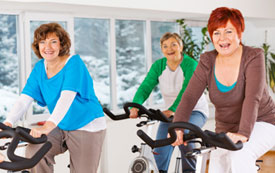 A recent study published in the Archives of Internal Medicine suggests that women who are physically active during middle age are more likely to have a healthy mind and body at age 70. Researchers looked at data from more than 13,000 generally healthy women who took part in the Nurse’s Health Study in 1986. On average, the women were 60 years old.
A recent study published in the Archives of Internal Medicine suggests that women who are physically active during middle age are more likely to have a healthy mind and body at age 70. Researchers looked at data from more than 13,000 generally healthy women who took part in the Nurse’s Health Study in 1986. On average, the women were 60 years old.
During the next 14 years, and until the end of the study, they underwent physical, cognitive, and mental health assessments.
Women were considered “successful survivors” if they were alive and free from the following health problems during the study period:
- Major illnesses, such as cancer, diabetes, and heart failure.
- Cognitive decline.
- Physical limitations.
- Mental health problems.
Exercise and Aging Well
To find out if physical activity was linked with successful survival, women were grouped into five activity levels and compared with those who were the least active. Women in the least active group spent less than one hour per week doing light activity, such as walking at an easy pace.
The study showed that women who were more physically active had better odds of being healthy at age 70. In fact, the odds for being a successful survivor were nearly double for the most active women. These women got the equivalent of at least 3.3 hours per week of vigorous activity, such as jogging, biking, or swimming.
But even moderate-intensity activity, such as walking, was linked with successful aging. Women who walked the equivalent of at least two hours at a modest pace each week had 50 percent higher odds to be successful survivors than those who walked the least.
In fact, the more time spent walking and the faster the pace, the better the odds were of staying healthy. Those who walked at a moderate pace were almost twice as likely to be healthy at age 70 as those who walked at an easy pace. Those whose pace was brisk were almost three times as likely to be successful survivors.
A pace below 2 miles per hour (mph) was considered easy. A moderate pace was 2 to 2.9 mph, and a brisk pace was at least 3 mph.
Physical Activity and Health
Cooper internist Rosemarie A. Leuzzi, MD, Medical Director of the Ripa Center for Women’s Health and Wellness, notes that regular exercise of any kind is what contributes to better health — both now and in later years.
“Physical activity has been shown to improve cardiac status and lower the risk for diabetes and stroke, as well as delay cognitive decline in the elderly. I certainly recommend to patients that they try to do some form of exercise for 30 minutes per day, 4 to 6 times per week. This can also be broken down into several shorter periods throughout the day. Exercise can be any physical activity, including housework, yard work, walking/dancing, or an exercise DVD/WII program. I encourage patients to find activities that they enjoy and that can be easily incorporated into their daily schedules,” Dr. Leuzzi said.
If you do choose to start a walking program, here are a few tips to keep in mind:
Keep it safe. Bring a friend along or walk with a group. Wear a reflective vest or bright colors when walking at dusk, dawn, or night.
Start slowly. Gradually work up to walking at least 30 minutes on most days. Each time you walk, warm up for five minutes by walking slowly. Then, pick up the speed until your heart is beating faster and your lungs breathing deeper. Finally, cool down by walking slowly for another five minutes.
Calculate your pace. To figure out your walking pace, divide your distance walked in miles by your time spent walking in hours. For example, your pace would be 4 mph if you walked 2 miles in 30 minutes (2 miles ÷ 0.5 hrs = 4 mph).
Always consult your physician for more information.
